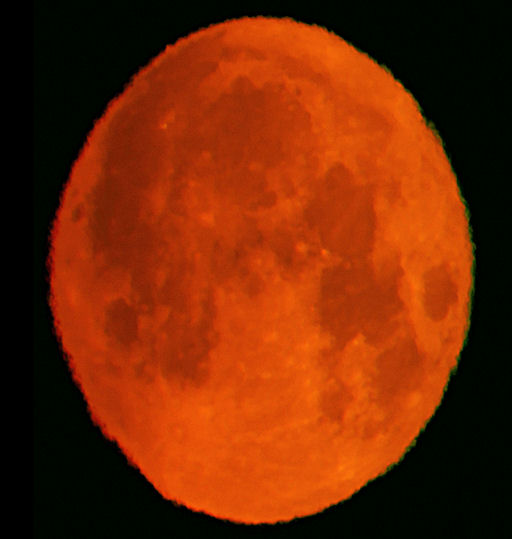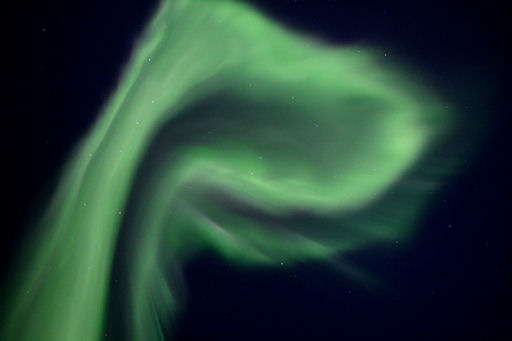INCOMING CME: NOAA forecasters estimate a 25% chance of strong geomagnetic storms around the poles on April 8-9 when a CME delivers a glancing blow to Earth's magnetic field. The cloud was propelled in our direction by a solar filament, which erupted on April 5th (movie). High-latitude sky watchers should be alert for auroras. Aurora alerts: text, phone.
EGG MOON: Last night's full Moon, the first full Moon of northern spring, is sometimes called the "Egg Moon" because of its association with Easter. As it watched the moon rise over Cape Elizabeth, Maine, photographer John Stetson didn't think it looked much like an egg--that is, until he tilted his head 90 degrees:
"The earth's atmosphere provided beautiful color and distorted the shape of our moon as it appeared on the horizon," says Stetson. "The red rim on the lower part of the moon and the green rim on the upper part of the moon was particularly evident tonight. Many observers shared this view at the eyepiece. Happy Easter to all."
more images: from Anthony Ayiomamitis of Athens, Greece; from Will Wickham of Corning, NY; from Fritz Helmut Hemmerich of Tenerife, Canary Islands;
WEEKEND AURORAS: Last night, April 6-7, parts of the high Artic Circle were alight with auroras so bright even the full Moon couldn't overwhelm them. In the village of Ivujivik, Nunavik (Canada), many of the luminous formations reminded onlooker Gilles Boutin of flowers:
"Voici les Auroras flower of Nunavik," says Boutin. "J`ai capté les aurores au zénith soit des couronnes boréales alors voici de magnifiques fleurs boréales de Ivujivik, Nunavik."
More auroras are possible on April 8th and 9th when a CME is expected to hit Earth's magnetic field. NOAA forecastesr estimate a 25% chance of strong geomagnetic storms around the poles. Aurora alerts: text, phone.
more images: from Yuichi Takasaka of Yellowknife, Northwest Territories, Canada; from Shawn Malone of Marquette, Michigan; from Michael Noble of Cooking Lake, SE of Edmonton, Alberta, Canada

![]()
Solar wind
speed: 369.9 km/sec
density: 1.3 protons/cm3
explanation | more data
Updated: Today at 1606 UT
![]()
X-ray Solar Flares
6-hr max: B2 1439 UT Apr07
24-hr: B7 0936 UT Apr07
explanation | more data
Updated: Today at: 1600 UT
![]()
![]()
![]()
Daily Sun: 07 Apr 12
![]()
![]()
With only one significant spot on the Earthside of the sun, solar activity is low. Credit: SDO/HMI
![]()
![]()
![]()
Sunspot number: 39
What is the sunspot number?
Updated 06 Apr 2012
Spotless Days
Current Stretch: 0 days
2012 total: 0 days (0%)
2011 total: 2 days (<1%)
2010 total: 51 days (14%)
2009 total: 260 days (71%)
Since 2004: 821 days
Typical Solar Min: 486 days
Updated 06 Apr 2012
The Radio Sun
10.7 cm flux: 97 sfu
explanation | more data
Updated 06 Apr 2012
![]()
![]()
![]()
Current Auroral Oval:
![]()
Switch to: Europe, USA, New Zealand, Antarctica
Credit: NOAA/POES
![]()
![]()
![]()
Planetary K-index
Now: Kp= 3 quiet
24-hr max: Kp= 3 quiet
explanation | more data
![]()
Interplanetary Mag. Field
Btotal: 6.3 nT
Bz: 4.0 nT north
explanation | more data
Updated: Today at 1607 UT
![]()
![]()
![]()
Coronal Holes: 06 Apr 12
![]()
![]()
A wide equatorial coronal hole is turning toward Earth. Solar wind flowing from the dark gash should arrive on April 12-13. Credit: SDO/AIA.






